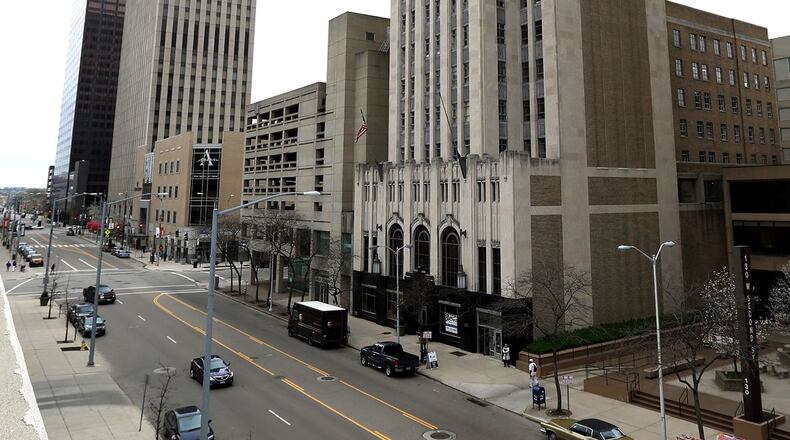If the city is successful, the designation would save downtown building owners a lot of time and around $10,000 to $15,000 each in costs tied to getting properties added to the National Register of Historic Places, city staff said.
But the city’s application is more unconventional than the average historic district because downtown has a wide range of architectural styles and a wide period of historical significance, said Tony Kroeger, Dayton’s planning division manager.
“It’s more of the story of the development of downtown Dayton — it’s more thematic than straight up architectural significance,” he said.
MORE: Dayton could become Ohio’s largest city with downtown historic district
Last week, city of Dayton and State Historic Preservation Office staff gave a presentation at City Hall about the city’s National Register application to create a Downtown Dayton Historic District.
The city has completed a draft nomination for placement on the National Register, which is with the State Historic Preservation Office, staff said.
On March 22, the application will go before the Ohio Historic Site Preservation Advisory Board for consideration.
The proposed downtown historic district spans more than 36 blocks in the Dayton’s commercial district and covers about 220 acres.
The district runs from Interstate 75 to the west to St. Clair Street and Patterson Boulevard to the east.
Monument Avenue is the northern boundary line. Sixth Street and the Norfolk Southern railroad line are the southern boundaries.
MORE: Why these new residents decided to live in downtown Dayton
The area has 87 buildings that “contribute” to the historical significance of the district and 38 that do not, according to the city of Dayton’s National Register of Historic Places registration application.
This does not include other buildings and sites in the targeted area that are already listed on the National Register.
Buildings in the district have styles ranging from 19th- and 20th-Century revival styles to mid-20th Century modernism, the city said.
The district’s period of historical significance stretches from about 1865 to 1980, which covers Dayton’s thriving times as an industrial and commercial center to its more challenged years when it lost jobs, businesses and people to the suburbs, the application states.
Some notable contributing buildings are in the art deco-style and were constructed as part of urban renewal efforts in the 1960s.
In the new district, building owners will not face new restrictions except if they want to tear down the structures using federal dollars, Kroeger said.
The main benefit will be that contributing buildings in the new district would be eligible for federal historic tax credits and state historic tax credits, which are competitive and in high demand, Kroeger said.
RELATED: The $6M ask: Developers seek funds for Dayton office, housing projects
The creation of the new district will provide some certainty for people and groups interested in investing in downtown buildings or projects, Kroeger said.
The listing process takes time, buildings aren’t guaranteed to make the list and it costs money to do the historic research necessary for a successful application, Kroeger said.
“The driving force behind this was the practical implication of eligibility for state and federal historic tax credits,” he said.
He said there a variety of buildings that can take advantage of the state and federal historic tax incentive programs.
Preservation Dayton Inc.’s 12 trustees unanimously voted to endorse the city’s request for historic designation.
Much of the renovation and investment in Dayton properties only has been possible because the buildings were on the National Register and received historic tax credits, wrote Preservation Dayton Inc. Vice President Monica Snow in a letter supporting the city’s efforts.
“This proposed designation will simplify the process for applying (for) tax credits, provide a major incentive to attract more positive investment in the city and preserve the value of our region’s architectural treasures,” she wrote.
The creation of the new historic district could be a valuable development tool for downtown, said Janet Bly, general manager of the Miami Conservancy District, whose building on East Monument Avenue was built in 1915.
The feedback at last week’s meeting was positive and the city and other presenters made a persuasive case that downtown’s buildings tell Dayton’s history, Bly said.
RELATED: Loss of tax incentives would be ‘devastating’ for Dayton
About the Author

